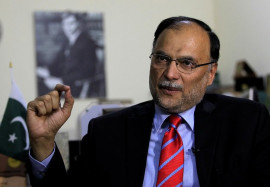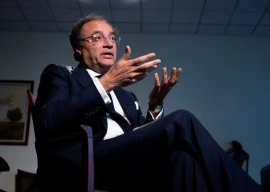
KARACHI: Half an hour before sunrise a convoy of SUVs, police pickup trucks - both marked and unmarked - sedans and armoured personnel carriers converged on Maulana Yousuf Ludhviani Shaheed Road and surrounded Rufi Rose Petals bungalows and Block 2 of the nearby Kaneez Fatima Society.
Most residents of the neighbourhood were sound asleep, except for the few who had already risen or the late-sleepers who were just getting ready for bed.
The pin-drop silence in the neighbourhood was broken by the tinny sound of music being played by rooftop revellers enjoying Eid barbeques. The slamming of vehicle doors and clomping of boots on the asphalt echoed in the almost silent streets.
“I was in the bathroom when I heard a few shots, followed by a round of gunfire. I quickly realised it wasn’t aerial firing and was actually an exchange of fire,” said M*, a resident of the area who lives on the same street where the September 4 predawn raid was conducted. The raid was jointly conducted by the police and other law enforcement agencies to apprehend suspected militants of Ansarul Sharia Pakistan.
Abdul Karim Sarosh Siddiqui and Sheharyar alias Abdullah Hashmi – friends, neighbours and former students of applied physics at the University of Karachi (KU) - were the targets.
A tale of two terrorists
Armed men in uniform and plainclothes took their positions in the streets where Sarosh and Sheharyar lived, according to neighbours who spoke to The Express Tribune. As the gun battle in Rufi Rose Petals raged on, law enforcers ensured people stayed inside their homes and did not peer out their windows or balconies. “They signalled to whoever curiously tried to gain first-hand knowledge of what was happening to go back by pointing their guns towards them,” said M.
It later emerged that Sarosh, along with two others, identified by the police as Muzammil and Talha, escaped the raid while killing a policeman and injuring another, according to the official version. Sources, however, suggest there were two more casualties on the law enforcement side.
According to the police, the three suspects were spotted in the street and, as soon as they figured out that the circle of law enforcement officers was narrowing in on them, they opened fire. They then entered Sarosh’s house, went upstairs and began firing from the windows. The police casualties were reported when law enforcers entered the house and faced off with the suspects.
“The way they fought and escaped showed the kind of training they had received as militants. And, of course, it seems a case of classic incompetency on the part of the police,” commented a neighbour who witnessed the action from a distance. “Since then the residents, mostly the youngsters, are stressed about the possibility of more raids. Those who were just acquaintances of the suspects also fear arrest.”
Seven ‘terrorists’, 20 Afghan nationals detained in Punjab IBOs
Meanwhile, the contingent of law enforcers rounded up more than a dozen people by entering selected houses and performing identification checks. They were accompanied by men wearing bulletproof vests but without weapons, who residents suspected were informants or agents aiding the law enforcers in arresting people.
The identity of those picked up emerged later - they were relatives, friends and close acquaintances of Sarosh, Sheharyar, Muzammil and Hassan Israr, one of the suspected assailants who was allegedly killed in an encounter with the police after the attack on Muttahida Qaumi Movement - Pakistan leader Khawaja Izharul Hassan on September 2. They all lived in the same area.
No law enforcement agency has officially acknowledged the arrest of the suspects’ friends and family members but some officers have unofficially confirmed that these people are being interrogated for leads that could result in the arrest of the suspected militants.
It is said that this operation was jointly conducted by intelligence agencies and the police. The suspects had been under surveillance for months before Israr was identified as one of Khawaja Izhar’s attackers. The attack prompted law enforcers to jump into action.
In the wake of the attack, law enforcement agencies have made arrests, some said to be of high-profile militants, across the country. Among those in custody are a professor and man who is either a seminary teacher or administrator.
Seven 'terrorists' arrested in Karachi madrassa raid
The educational background of the suspects has raised eyebrows about the activities of militant groups said to be active at colleges and universities in the country. However, according to the Counter-Terrorism Department’s senior officer SP Raja Umar Khattab, it would be wrong to suggest that militant tendencies have gained momentum amongst students since the Safoora bus attack in 2015.
“Those involved in Wall Street Journal journalist Daniel Pearl’s murder were also university graduates,” said Khattab. One of the prime suspects in the journalist’s murder, Omar Saeed Sheikh, who was later convicted for the felony by an anti-terrorism court, studied at the London School of Economics.
Militants can be found anywhere but what matters the most is their family background, he added. “In these cases, most militants hail from ultra-religious families. Rather than taking part in co-curricular activities, they prefer to get involved in religion and education. They are highly intelligent and unsurprisingly do well in school.”
Khattab said the situation is an outcome of the 2004-05 phenomena of jihadi narratives upheld by different religious-political organisations and other groups. “[The militants] were young when they listened to the speeches against America and others [Western countries] and attended gatherings where this was being preached. Upon reaching a mature age, they started believing that all those narratives were true,” he explained. Unfortunately they then tilted towards their own country, he said.
Two Lashkar-e-Jhangvi terrorists break out of Karachi jail
They have psychological problems, he theorised, referring to their short tempers and emotional vulnerability.
“In this [Ansarul Sharia Pakistan] case, they believe that their self-styled khilafat system of government is the remedy to all the problems Muslim countries, including their own country, face. They like to believe that they are the most righteous and virtuous of people.”
Khattab said this superiority complex is common among those involved in terrorism, regardless of their ideological affiliation, be it religious, liberal or gang-related. “It is a problem that most of our youths have been facing. And social media is an open platform for them to connect with each other and propagate their narratives to attract likeminded people.”
Parents should keep a check on their children and must monitor what they do on social media, he suggested. “Saad Aziz [one of the Safoora attack convicts] was not radicalised from the beginning. He was like any other young man but a specific environment influenced him,” he explained. “To join militant operations, he would tell his family he was going for tableegh [preaching] and they believed him.”
Contrary to the perception that militants emerge from a specific ethnicity, region or background, the officer said most militants being discussed today are Urdu speakers. “The militant godfathers think globally and are targeting brilliant young minds around the world as an investment for their future. Once radicalised at a tender age, they can easily be provoked at a mature age,” Khattab said.
He defined a pattern in which radicalised people from the upper and middle class would preach and arrange financing while those from the lower and middle class would engage in direct militancy. “Once they engage in jihad or a militant operation in the country, they develop a tendency that can only be satisfied by either going back there or indulging in the same here.”
Three terrorists involved in attacks on Karachi police arrested
A similar case was reported in Jamshoro when a student at Liaquat University of Medical and Health Sciences (LUMHS), Noreen Laghari, was found to be involved with the Da’ish. She was apprehended by security forces before she carried out an attack.
According to Professor Noshad Sheikh, vice-chancellor of LUMHS, most radicalised youths were left unattended by their parents and extremists took advantage of it. Meanwhile, he blamed social media for being the prime tool for radicalisation. As a counter strategy, he suggested that relations should be fostered between parents, teachers and students.
“Parents and teachers should develop a relationship through which young minds would feel free to reveal their thoughts to them,” said Prof Shaikh, drawing the government’s attention towards uplifting the standards at educational institutions. “For a long time, security agencies have only focused on seminaries, while extremists have been infiltrating [other] educational institutions.”
On the other hand, KU Vice-Chancellor Dr Muhammad Ajmal Khan stressed the need to revive student unions and bodies independent of mainstream politics. “This would give them an opportunity to openly discuss their issues through debates, conferences and other activities. They will be able to learn the art of living themselves,” he explained.
Counter-terrorism expert Amir Rana seconded that militant outfits have been targeting intelligent young minds at colleges and universities. He said that it was in the 1980s and 1990s when the youth started being attracted towards militancy and the militant narrative penetrated so deeply into society, due an apparent backing from a certain quarters in the power corridors, which made a considerable number of Intermediate and bachelor’s students vulnerable to militancy.
CTD to monitor 116 'terrorists' released due to lack of evidence
“A university student-turned-militant gets more attention than a seminary militant. This ultimately helps the militants,” he said. “They are creating examples for them within society. We need to look closely at the angles of the videos from Syria, Iraq, Afghanistan and other countries to develop a counter strategy. In this state, radicalisation is just a click away.”
In every era, there is a specific tool to wage wars and induct militants, Rana explained. “It has been in the form of printed material like magazines, booklets, pamphlets, brochures and CDs and sometimes in the form of friends or colleagues to exert peer pressure on the target. However, today the most widely used tool is social media and it’s more dangerous than all other forms.”
*Name changed to protect privacy









































1713521455-0/Untitled-design-(9)1713521455-0-270x192.webp)














COMMENTS
Comments are moderated and generally will be posted if they are on-topic and not abusive.
For more information, please see our Comments FAQ